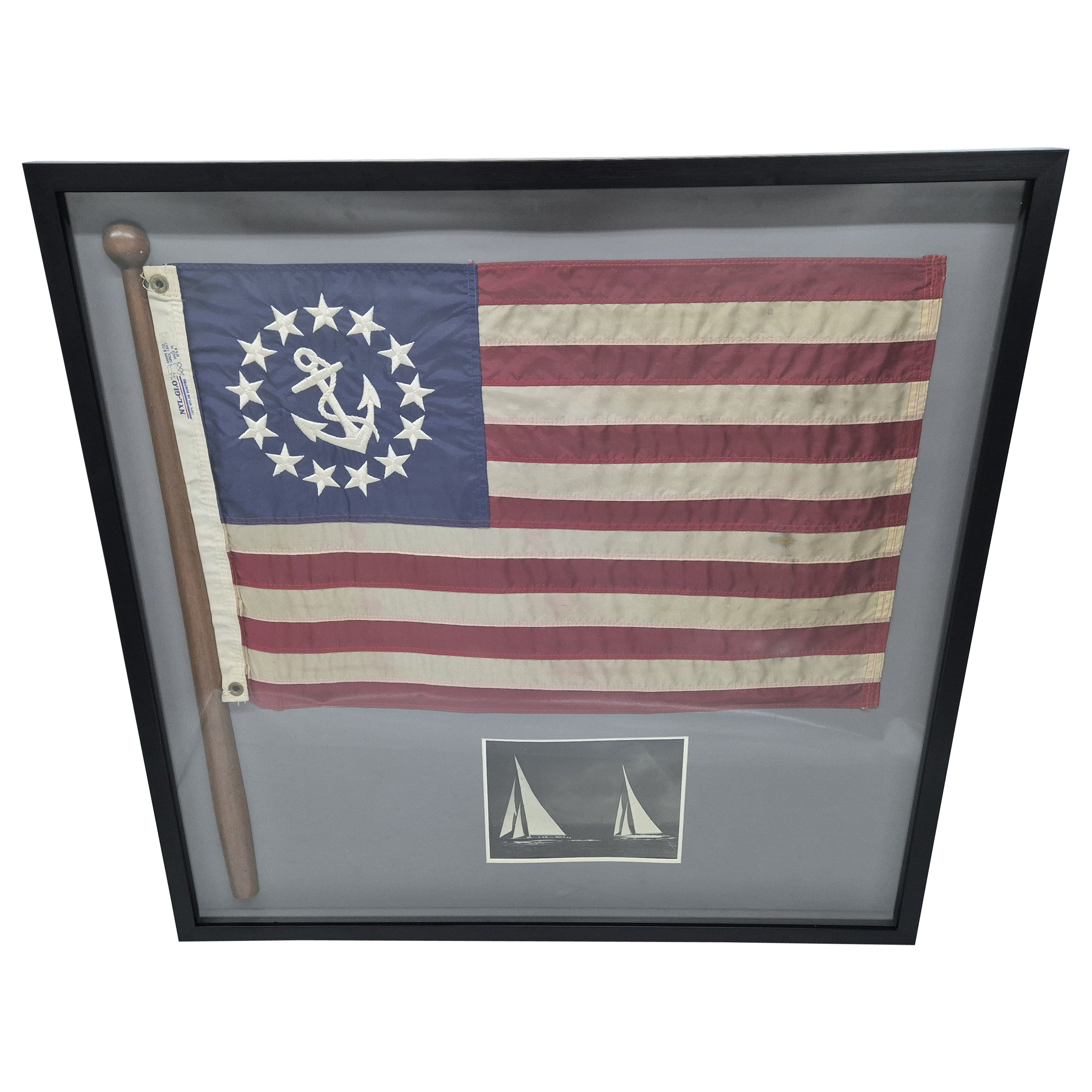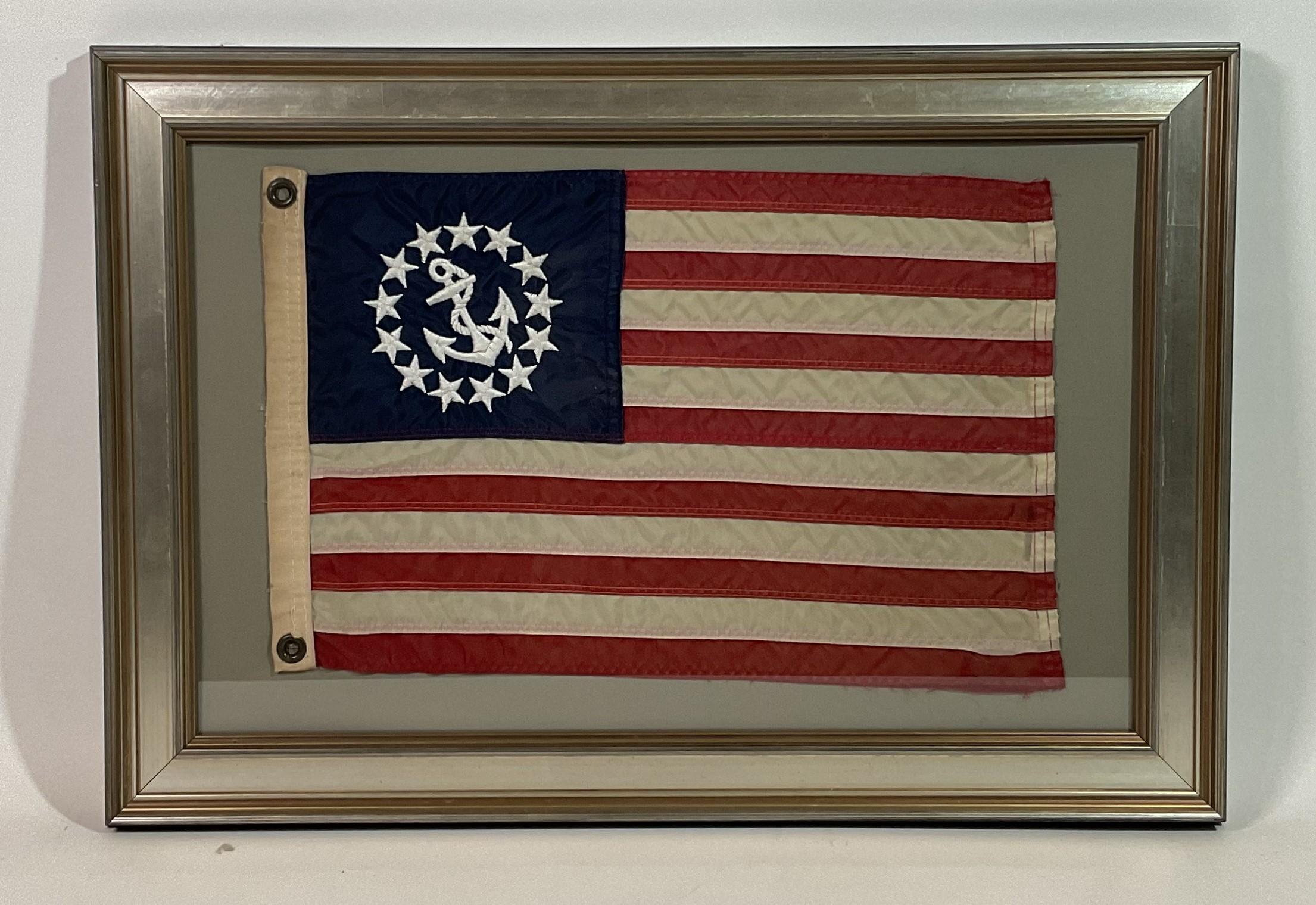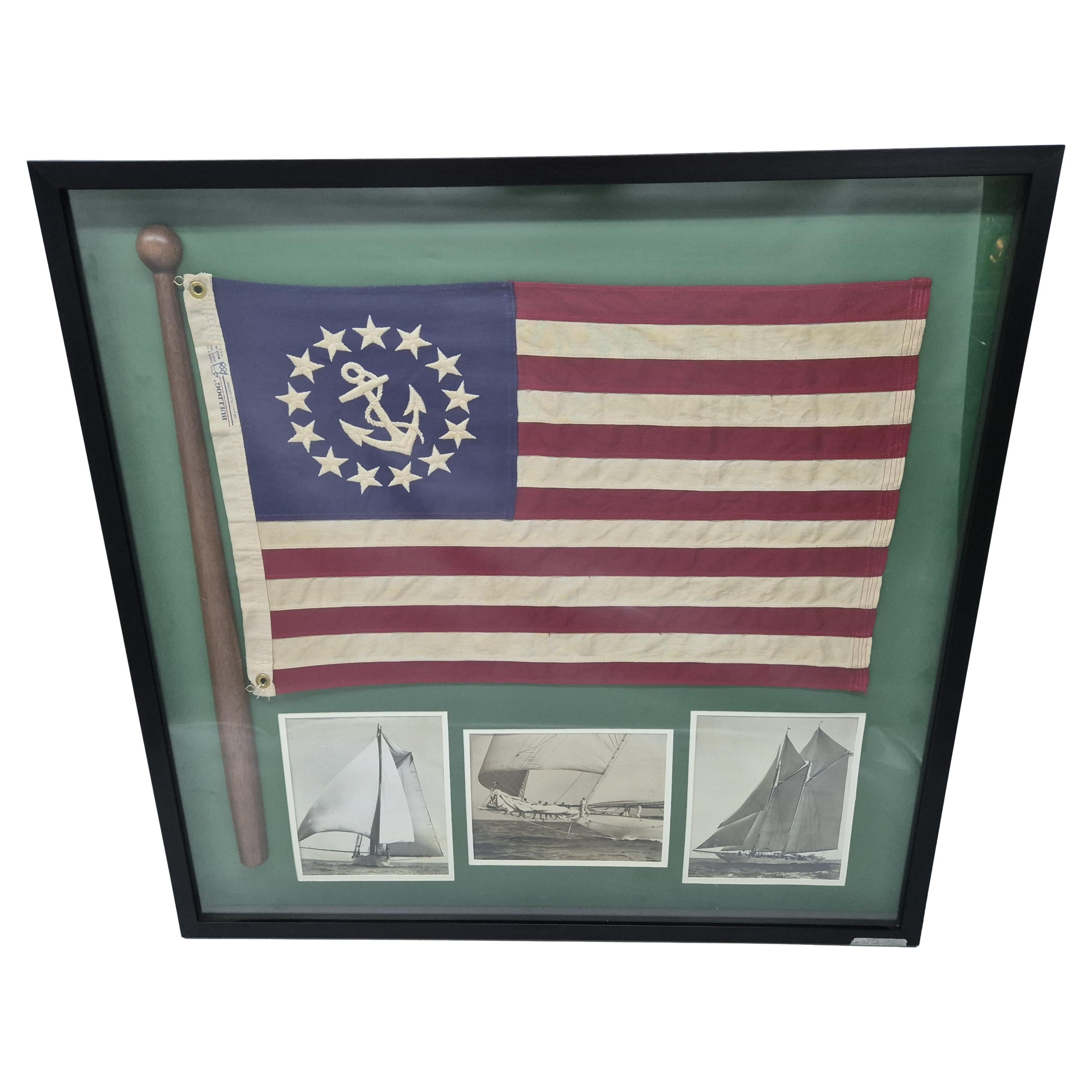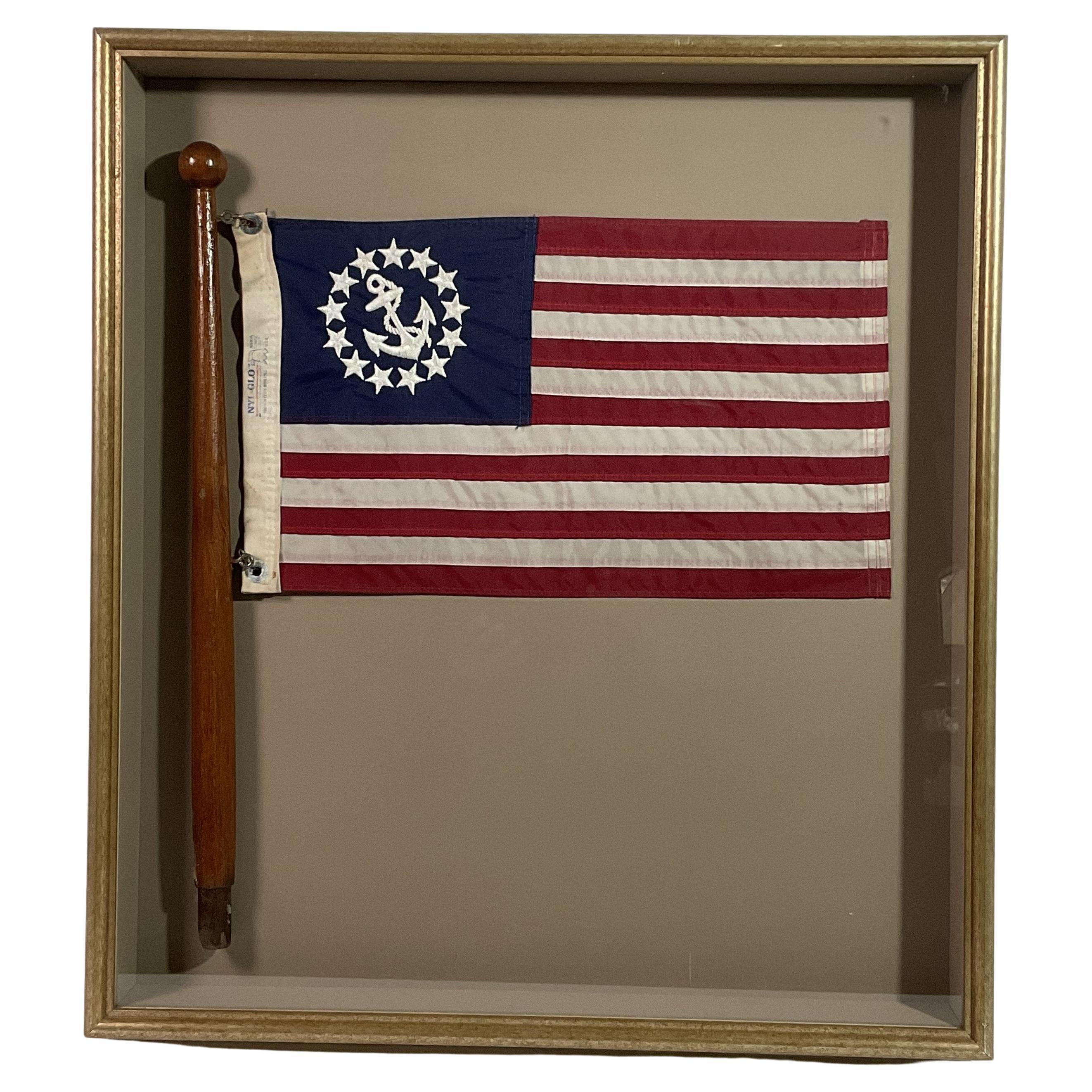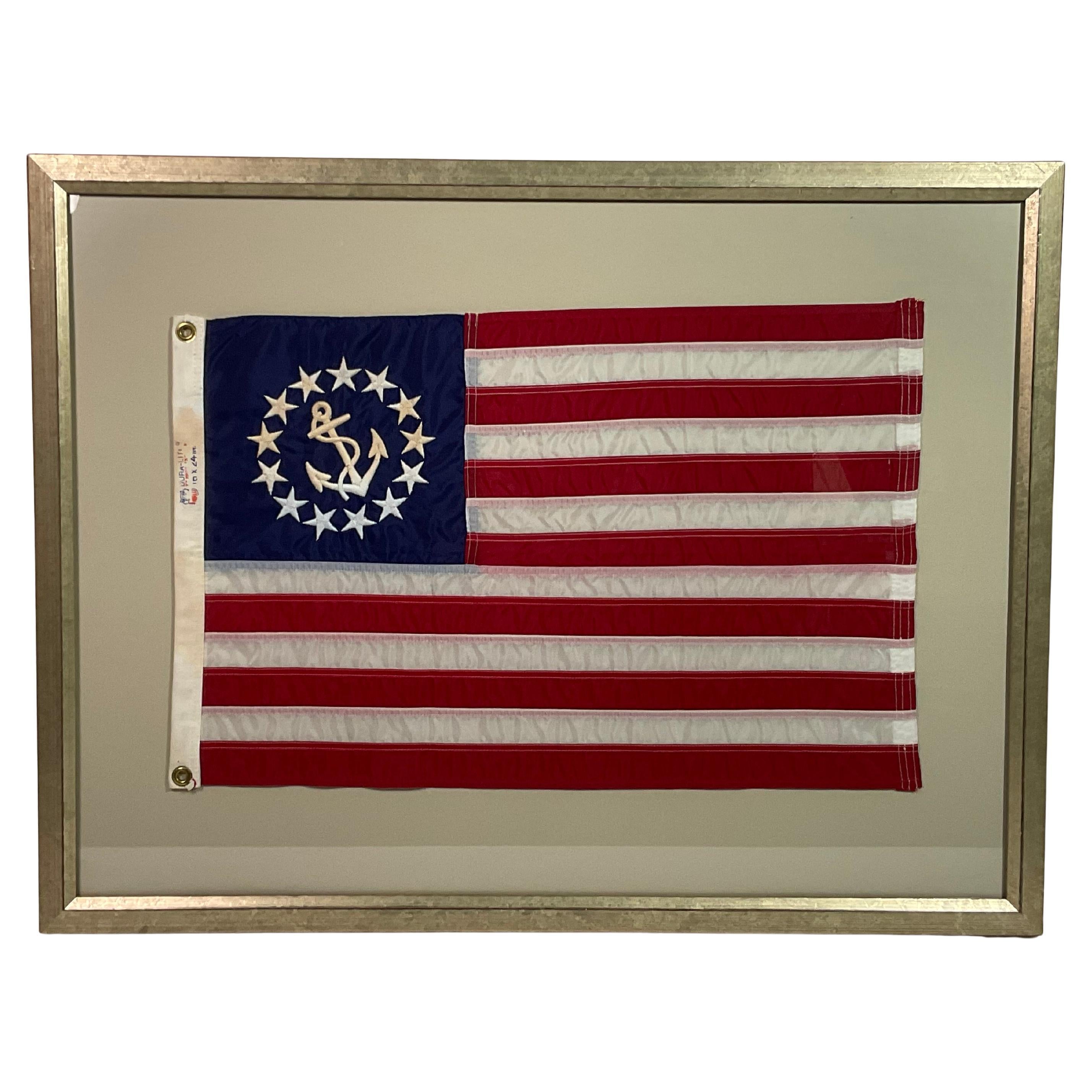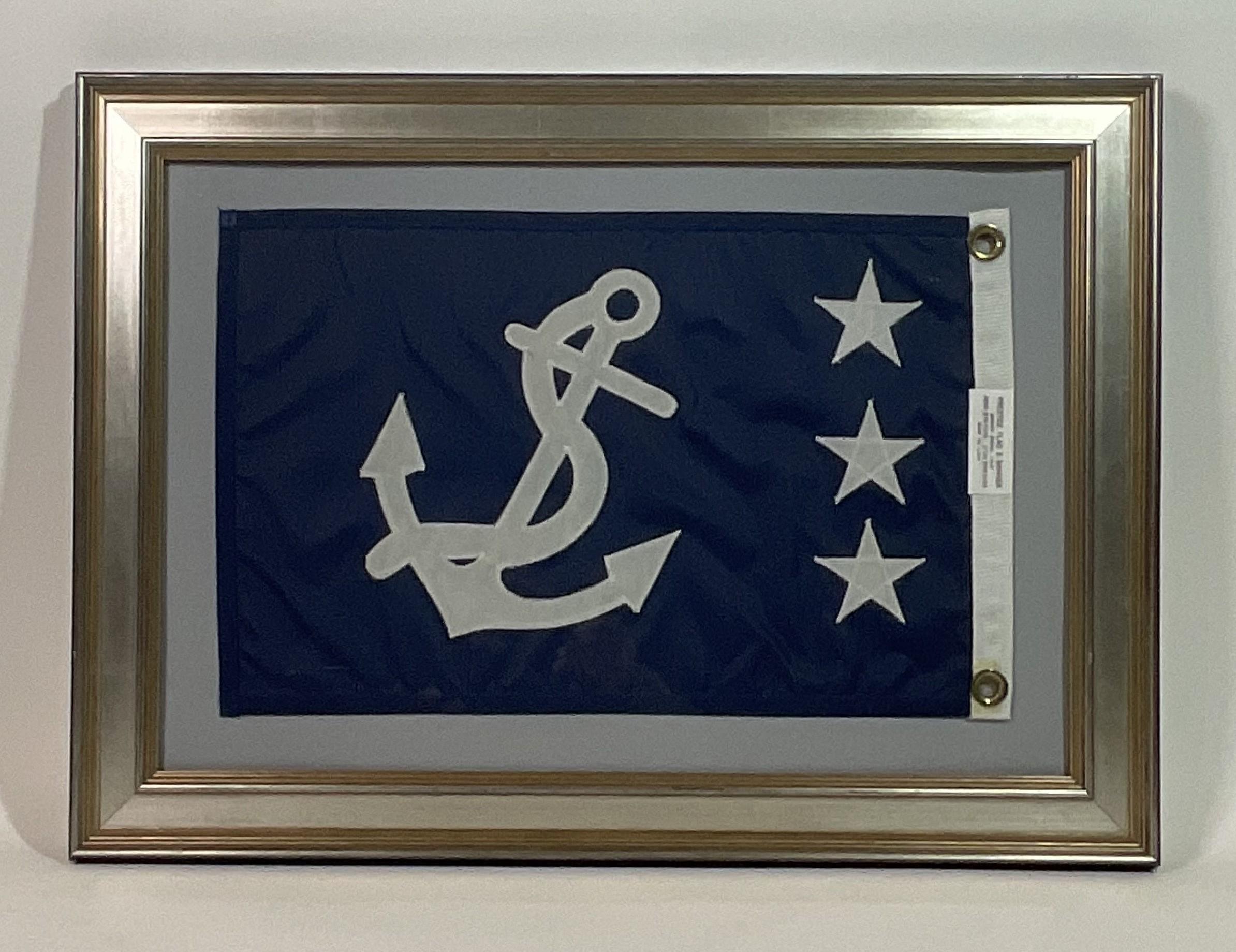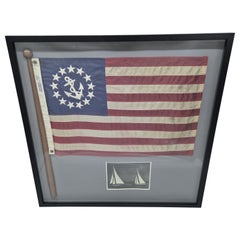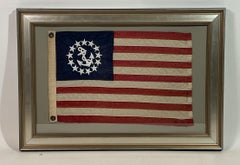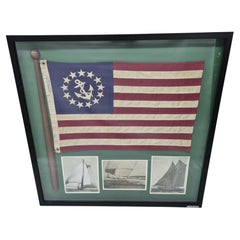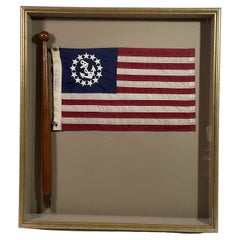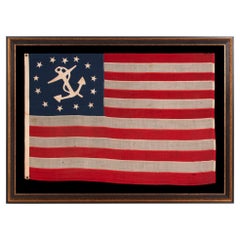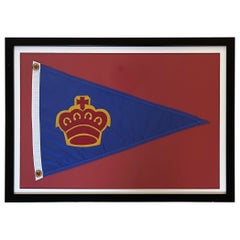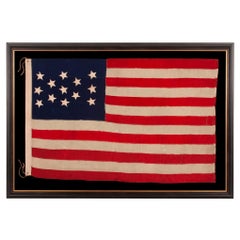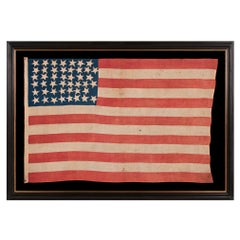Items Similar to Old Yachting Ensign Flag in a Shadowbox Frame
Want more images or videos?
Request additional images or videos from the seller
1 of 10
Old Yachting Ensign Flag in a Shadowbox Frame
$475
£358.77
€414.63
CA$666.26
A$741.05
CHF 387.85
MX$9,038.40
NOK 4,873.49
SEK 4,584.15
DKK 3,094.84
About the Item
Antique boat flag with a fouled anchor and thirteen stars in the blue field. The United States yachting ensign was created by Congress in 1848 to identify yachts that didn't need to clear customs when entering ports. It indicates no cargo is being carried. Otherwise, it is smuggling. The flag is mounted to beige matting with a black shadowbox frame.
Weight: 6 lbs.
Overall Dimensions: 20"H x 26"W
Made: America
Material: Cotton
Date: 1960
- Dimensions:Height: 20 in (50.8 cm)Width: 26 in (66.04 cm)Depth: 2 in (5.08 cm)
- Materials and Techniques:
- Place of Origin:
- Period:
- Date of Manufacture:1960
- Condition:
- Seller Location:Norwell, MA
- Reference Number:Seller: F1061stDibs: LU1741245822532
About the Seller
5.0
Vetted Professional Seller
Every seller passes strict standards for authenticity and reliability
Established in 1967
1stDibs seller since 2015
415 sales on 1stDibs
Typical response time: 1 hour
- ShippingRetrieving quote...Shipping from: Norwell, MA
- Return Policy
Authenticity Guarantee
In the unlikely event there’s an issue with an item’s authenticity, contact us within 1 year for a full refund. DetailsMoney-Back Guarantee
If your item is not as described, is damaged in transit, or does not arrive, contact us within 7 days for a full refund. Details24-Hour Cancellation
You have a 24-hour grace period in which to reconsider your purchase, with no questions asked.Vetted Professional Sellers
Our world-class sellers must adhere to strict standards for service and quality, maintaining the integrity of our listings.Price-Match Guarantee
If you find that a seller listed the same item for a lower price elsewhere, we’ll match it.Trusted Global Delivery
Our best-in-class carrier network provides specialized shipping options worldwide, including custom delivery.More From This Seller
View AllUnited States Yacht Ensign Flag in Shadowbox Frame
Located in Norwell, MA
Yacht ensign on wood pole and three black and white yacht photographs mounted into a shadowbox frame. The flag has an embroidered anchor and thirteen ...
Category
Vintage 1960s North American Nautical Objects
Materials
Cotton
Framed Nautical Flag of a Yacht Ensign
Located in Norwell, MA
Framed yacht ensign flag with embroidered fouled anchor surrounded by stars in the blue field. This panel identifies a vessel as a pleasure craft, not a commercial vessel.
Weight: ...
Category
Vintage 1920s North American Nautical Objects
Materials
Cotton
United States Yacht Ensign Flag in Shadowbox Frame
Located in Norwell, MA
Yacht ensign on wood pole and three black and white yacht photographs mounted into a shadowbox frame. The flag has an embroidered anchor and thirteen ...
Category
Vintage 1960s North American Nautical Objects
Materials
Cotton
Yacht Ensign on Pole in Shadowbox Frame
Located in Norwell, MA
Shadow box with a yachting flag that has an embroidered fouled anchor and stars in the blue field, attached to a varnished pole set into a shadowbox frame. Great nautical accent.
We...
Category
Vintage 1950s North American Nautical Objects
Materials
Cotton
American Nautical Yacht Ensign Flag
Located in Norwell, MA
Framed American yacht ensign flag. Nautical flag with a blue panel that has an embroidered fouled anchor and thirteen stars, and red and white stripes with a canvas hoist and brass g...
Category
Vintage 1960s North American Nautical Objects
Materials
Cotton
Framed Nautical Yachting Flag
Located in Norwell, MA
Marine flag showing a fouled anchor with three stars, which signify that a past yacht club's commodore is on board. Blue field with white anchor and stars,...
Category
Vintage 1950s North American Nautical Objects
Materials
Cotton
You May Also Like
Outstanding 13 Star Hand-sewn American Private Yacht Flag, ca 1865-1885
Located in York County, PA
OUTSTANDING, 13 STAR, ANTIQUE AMERICAN PRIVATE YACHT ENSIGN WITH GREAT FOLK QUALITIES THAT INCLUDE AN UNUSUALLY WIDE ANCHOR AND A DECIDEDLY LOPSIDED RING OF 13 STARS; MADE DURING THE 2ND HALF OF THE 19TH CENTURY; ITS DEVICE HAND-SEWN AND SINGLE-APPLIQUÉD
Private yacht ensigns were approved American signals for maritime use that allowed pleasure boats to bypass customs. Though the legislation that approved them was adopted prior to 1850, almost all such flags that one will encounter were sewn by electric machine and made during the 20th century. The unusual gems among surviving examples are those that are earlier and include hand-sewn elements. Even more rare are a select few with atypical graphics. Barely any fall into both of these categories at once. Take note of the anchor on this particular flag, wide a long horizontal crossbar (stock) that contributes to uncommonly wide stance. Set within a ring of stars that is decidedly lopsided, the result is as bold as it is endearingly whimsical—two of the best qualities in American folk art, a category in which this particular example can be filed. While I have owned 13 star private yacht flags that have displayed star and canted anchor devices that were somewhat larger and/or bolder than typical, I cannot recall any that were so graphically intriguing as this one.
Brief History of Private Yacht Ensigns:
The medallion configuration, 13-star, 13-stripe flag, with a canted center anchor was entered into official use in 1848, following an act of Congress, that made it the official signal for U.S. pleasure sailing vessels. The need for such a flag arose with the popularity of boating as a pastime for well-to-do Americans, and as a competitive sport, in addition to its longstanding utilitarian role as a vehicle of trade. In early America, all boats were subject to customs searches at every port. Without modern income tax, the federal government derived its revenues mostly from tariffs, so an accounting of foreign goods on ships was a critical venture. As yachting for pleasure became more prevalent, however, more and more time was spent searching boats that had no such inventory, wasting time for both customs officials and wealthy ship owners.
John Cox Stevens, a former president of the Jockey Club and future founder of the Union League Club, became the New York Yacht Club’s Commodore upon its founding in 1845. In 1847 he approached the secretary of the treasury and suggested that something be done to streamline the customs process for non-trade vessels. In 1848, legislation passed Congress requiring registration of these boats, which could then fly the “American Yachting Signal” to bypass customs. This remained on the books until the 1980’s, when the 1848 legislation was revoked, but the use of flags in this design for decorative function continues to this day.
13 star flags have been flown throughout our nation’s history for a variety of purposes. In addition to their use on private yachts, they were hoisted at patriotic events, including Lafayette’s final visit in 1824-25, the celebration of the nation’s centennial in 1876, and the sesquicentennial in 1926. They were displayed during the Civil War, to reference past struggles for American liberty and victory over oppression, and were used by 19th century politicians while campaigning for the same reason. The U.S. Navy used the 13 star count on small boats until 1916, because it was easier to discern fewer stars at a distance on a small flag. Commercial flag-makers mirrored this practice and some private ships flew 13 star flags during the same period as the Navy.
Construction: The stars and anchor are made of cotton, hand-sewn, and single-appliquéd. This means that they were applied to one side of the canton, then the blue fabric was cut from behind each star, folded over, and under-hemmed, so that one star could be viewed on both sides of the flag. I always find single-appliquéd stars more interesting, not only because they are evidence of a more difficult level of seam-work and stitching, but also because they are more visually intriguing. The two visible rows of hand-stitching emphasize their hand-sewn construction. For these reasons, single-appliquéd stars often appeal to connoisseurs of early American textiles...
Category
Antique Mid-19th Century American Political and Patriotic Memorabilia
Materials
Wool
Price Upon Request
Mid-Century Framed Yacht Club Flag
Located in San Diego, CA
A very cool mid-century framed yacht club flag, circa 1960s. The flag is presented in a black wood frame with a red back ground. The overall piece meas...
Category
Mid-20th Century American Mid-Century Modern Nautical Objects
Materials
Paper
$340 Sale Price
20% Off
13 Star Antique American Flag with a Narrow Star Presentation, ca 1876
Located in York County, PA
13 STAR ANTIQUE AMERICAN FLAG WITH HAND-SEWN STARS IN AN EXTREMELY NARROW PRESENTATION OF A 3-2-3-2-3 ARRANGEMENT ON A CANTON THAT DOESN’T FOLLOW SUIT, LEAVING WIDE EXPANSES OF BLUE ...
Category
Antique 1870s American Political and Patriotic Memorabilia
Materials
Wool
Price Upon Request
Homemade, Antique American Flag with Exceptional Folk Qualities, 1896-1908
Located in York County, PA
HOMEMADE, ANTIQUE AMERICAN FLAG WITH A TINY CANTON RESTING ON THE 6TH STRIPE AND AN EXTREMELY FOLKY PRESENTATION OF 45 STARS IN A “NOTCHED” PATTERN THAT MIGHT BE UNIQUE TO THIS EXAMP...
Category
Antique 1890s American Political and Patriotic Memorabilia
Materials
Cotton
Exceptional American Flag, 38 Stars in 3 Sizes in a Fantastic, Unusual Medallion
Located in York County, PA
EXCEPTIONAL ANTIQUE AMERICAN FLAG WITH 38 GLAZED COTTON STARS, IN 3 DIFFERENT SIZES, ARRANGED IN A BEAUTIFULLY GRAPHIC, DOUBLE-WREATH STYLE MEDALLION, WITH TRIANGLES OF 4 STARS IN ...
Category
Antique Late 19th Century North American Political and Patriotic Memorab...
Materials
Silk
26 Star Antique American Flag, with 11 Stripes, Michigan Statehood, ca 1837-1846
Located in York County, PA
26 STAR ANTIQUE AMERICAN PARADE FLAG WITH 11 STRIPES AND IT’S CANTON RESTING ON THE “WAR STRIPE.” THE EARLIEST KNOWN STAR COUNT FOR PRINTED EXAMPLES, 1837-1846, MICHIGAN STATEHOOD
2...
Category
Antique Mid-19th Century American Political and Patriotic Memorabilia
Materials
Cotton
